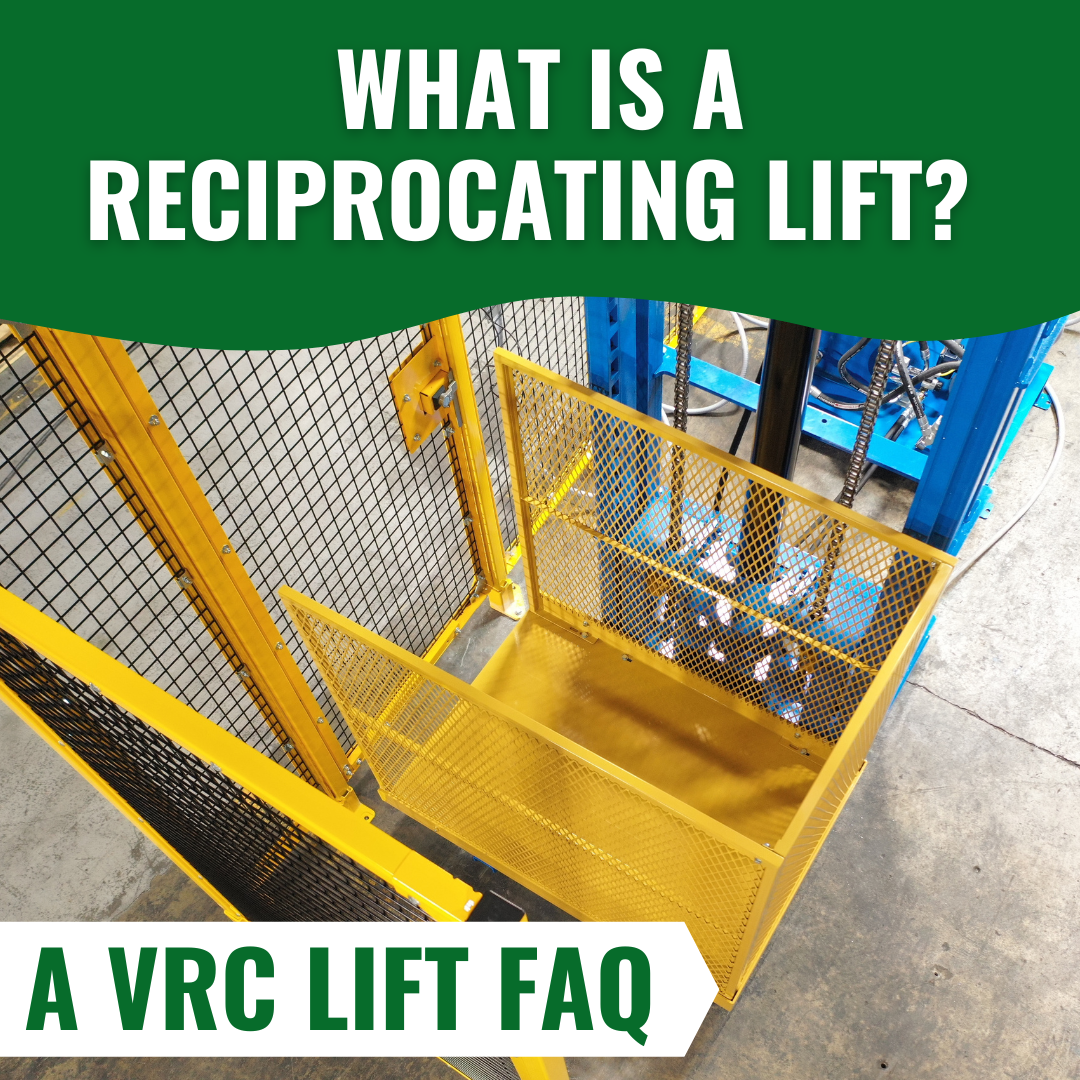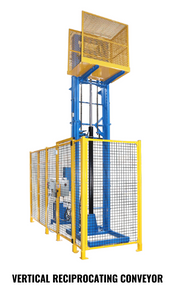We use cookies to make your experience better. To comply with the new e-Privacy directive, we need to ask for your consent to set the cookies. Learn more.
What Is a Reciprocating Lift? A VRC Lift FAQ
Material flow is a key challenge for industrial facilities, from distribution centers to manufacturing plants. How do you get materials, equipment, and finished products where they need to be, when they need to be there? 
Maybe you install an automated conveyor system, lines of powered rollers that keep materials moving without exposing workers to bodily stress. Maybe you use automated guided vehicles (AGVs), picking robots, or other autonomous material handling vehicles. Or maybe the trusty forklift fleet is enough to meet your throughput goals.
Regardless of how you move materials horizontally, single-story transportation may not be enough. Many facilities operate on more than one level, after all. Mezzanines, multi-story buildings, layered production lines: They all require a three-dimensional approach to material handling.
That can cause problems for conveyance systems focused on horizontal movement. You also need a vertical component, and the traditional approaches to vertical material movement for bulk materials — from pallet loads to equipment to vehicles themselves — aren’t always the most cost-effective options.
The simplest solution for vertical conveyance (and the one that often provides the best ROI) is called a reciprocating lift, a vertical reciprocating lift, or a vertical reciprocating conveyor (VRC, or VRC lift). Whatever you call them, you need to understand what they are, where they’re useful, and whether your facility will benefit from the technology. To help answer these questions, here’s a detailed FAQ about reciprocating lifts for business owners facing material handling challenges.
1. What is a vertical reciprocating lift?
A vertical reciprocating lift is a stationary machine that raises and lowers materials to move them between levels. These are permanent installations, not vehicles, and they must be built to fit into the spaces they serve. Each vertical lift consists of at least three components:
- A frame, which provides a travel path and guarding to keep surrounding operators safe while the unit is in use.
- The platform, or carriage, which rises and falls in a controlled manner, providing access to contents on two or more levels. Carriages are designed to match the materials and equipment VRC lift users handle; many are sized to handle full pallet loads, while others are built to lift whole trucks and other heavy equipment.
- The power unit, which provides the motive force necessary to raise and lower the carriage. Depending on the reciprocating lift, that may be a hydraulic system or a mechanical engine, both connected to lift chains that run the vertical length of the travel path.
In addition to these elements, a good VRC lift also includes multiple safety features, such as:
- Velocity fuses. These parts of a hydraulic system sense when pressure drops, indicating damage to a hydraulic hose. Without a velocity fuse, such an accident can cause an uncontrolled drop. With a fuse in place, the hydraulic system locks the carriage in place, preventing risk of serious injury and further damage to the lift and the materials it carries.
- Gate sensors. A VRC lift should only be operated when the carriage gate and, if present, higher-level access doors are closed. Otherwise, you run the risk of dropping materials. To prevent accidents, gate sensors prevent the unit from powering up until gates and doors are fully closed.
- Drop locks. Both mechanical and hydraulic reciprocating lifts should include drop locks, which detect damage to lift chains, then engage to freeze the carriage and prevent dangerous drops.
As this description suggests, a VRC lift bears a lot of similarities to one of the traditional approaches to vertical material handling: the freight elevator. In fact, the major difference between an elevator and a reciprocating lift is also the key to the lift’s lower cost of ownership, and faster return on investment.
2. What’s the difference between a VRC lift and an elevator?
The difference between a VRC lift and an elevator is, first and foremost, a legal distinction: You can carry people on elevators, but vertical reciprocating lifts are just for materials and equipment. If you need to move staff between levels, you have to choose an elevator — but if you only need vertical travel for materials, a VRC lift is a much more cost-effective choice.
This difference is reflected in the American Society of Mechanical Engineers (ASME) standards. Elevators are covered by ASME A17.1/CSA B44-2019: Safety Code for Elevators and Escalators. Vertical reciprocating lifts, on the other hand, must comply with ASME B20.1-2021. (Those standards are frequently updated; editions listed here reflect the most recent version as of publication time.)
While both standards are written to protect people working on and around elevators and conveyors, the risk is much higher for elevator passengers. That adds up to more stringent safety standards, which equate to higher costs for elevators compared with VRC lifts.
In addition to the ASME standards, local, state, and federal regulations often require frequent inspections and more in-depth preventative maintenance for elevators than for VRC lifts. These factors also contribute to the higher cost of an elevator.
In short, while elevators and reciprocating lifts perform similar tasks, the addition of human passengers adds up to extra costs. You’ll save considerable sums by using a dedicated VRC lift for materials if you don’t need to carry passengers to get the job done.
3. What are the benefits of reciprocating lifts?
Elevators aren’t the only way facilities accomplish vertical material handling in the absence of a reciprocating lift. You might depend on forklifts, instead. In fact, a VRC lift also provides lower costs — and more efficient operation — than rolling a forklift into place every time you need to move a pallet to a higher level.
Reciprocating lift carriages can handle materials that may not fit safely on lift truck forks. They don’t require a trained and authorized forklift operator, saving costs on OSHA forklift training. And they’re simply faster and safer than forklifts if your materials always move along the same vertical path.
In addition to the safety and cost benefits, a VRC lift provides:
- Greater efficiency, leading to higher throughput. Reciprocating lifts allow operators to move materials with the press of a button. It’s both faster and safer than rolling in a lift truck or operating a freight elevator, providing more productivity within your existing facility.
- Integration into broader material handling systems. Vertical reciprocating lifts bridge the vertical gap between horizontal material handling systems. They can be built into conveyor lines on both levels to create seamless, facility-wide material flow.
- Customization to meet unique needs. There’s no one standard VRC lift, nor should there be. Every installation must be designed to fit into an existing facility, with custom carriage sizes, unit footprints, weight capacities, and more.
- Smaller footprint than forklift lanes, inclined conveyors, and freight elevators. The footprint of a VRC lift isn’t much larger than the area of the carriage. That saves valuable space, leaving more room for revenue-generating activities.
Of course, reciprocating lifts aren’t a cure-all for every material handling challenge. Keep reading to find out if a VRC lift is the right solution for you.
4. How do you know when a reciprocating lift is right for your facility?
Reciprocating lifts tend to deliver the most value to facilities with some combination of the following factors: 
- You need to move materials between levels. That doesn’t just mean a multi-story building. It could include mezzanines, multi-level production lines, elevated platforms, and more.
- Materials flow along a set path. If your vertical transportation needs change location a lot, you’re probably better off with forklifts. But in set material handling systems — like automated conveyors — a VRC lift is ideal.
- You need to transport materials and/or equipment — not As mentioned above, reciprocating lifts aren’t for people. If you need a solution for getting staff up and down your facility, you’re stuck with elevators, escalators, stairs, etc.
Many facilities install reciprocating lifts as part of automated material handling systems that flow throughout the entire building. But you don’t necessarily need standardized material units to get value out of a VRC lift. Depending on the carriage size, you can elevate anything from a single box to multiple loaded pallets, and more, depending on changing needs.
If these conditions sound familiar, reciprocating lifts are the material handling solution you’re looking for. That just leaves one question left.
5. Where can you find a custom-built VRC lift for your facility?
As a dealer of BHS, Inc. equipment, the material handling experts at Solus Group can help you identify the specifications for a reciprocating lift that’s ideal for your unique needs. Outfit your facility with a custom Vertical Reciprocating Conveyor — with or without integration into your existing material handling system.
Ready to improve throughput with a reciprocating lift? Get started by calling Solus Group at 314-696-0200 today.
